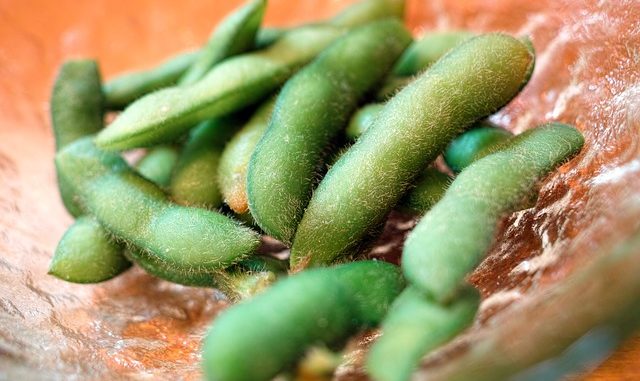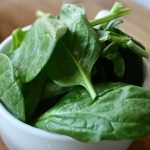
Edamame are immature green soybeans and are now one of the most fashionable foods to be found in health food aisles. It’s often found raw, steamed, dried and dry roasted, in pods, in ready meals and healthy salads. It has a pleasing, bursting texture in the mouth.
Nutrition: Edamame Beans, frozen and prepared
| Nutritional value per 100 g (3.5 oz) | |
|---|---|
| Energy | 509 kJ (122 kcal) |
|
Carbohydrates
|
9.94 g
|
| Sugars | 2.18 g |
| Dietary fiber | 5.2 g |
|
Fat
|
5.2 g
|
|
Protein
|
10.88 g
|
| Vitamins | |
| Thiamine (B1) |
(17%) 0.2 mg
|
| Riboflavin (B2) |
(13%) 0.155 mg
|
| Niacin (B3) |
(6%) 0.915 mg
|
| Pantothenic acid (B5) |
(8%) 0.395 mg
|
| Vitamin B6 |
(8%) 0.1 mg
|
| Folate (B9) |
(78%) 311 μg
|
| Vitamin C |
(7%) 6.1 mg
|
| Vitamin E |
(5%) 0.68 mg
|
| Vitamin K |
(26%) 26.8 μg
|
| Minerals | |
| Calcium |
(6%) 63 mg
|
| Iron |
(17%) 2.27 mg
|
| Magnesium |
(18%) 64 mg
|
| Manganese |
(49%) 1.024 mg
|
| Phosphorus |
(24%) 169 mg
|
| Potassium |
(9%) 436 mg
|
| Zinc |
(14%) 1.37 mg
|
Percentages are roughly approximated using US recommendations for adults. Source: USDA Nutrient Database.
Nutritional Benefits
Edemame beans are immature soybeans (Glycine max (L.) Merrill) and are harvested at 80% maturity.
Like all legumes including peas and beans, edemame is full of protein as well as fibre and fat but certainly low in carbohydrates relatively speaking. It also contains plenty of vitamin C and other key minerals such as magnesium, potassium, manganese and zinc. Some other useful vitamins include folate and in particular vitamin K.
Whilst edamame beans are not fully mature soy, some of the benefits of soy are most likely evident. Nutritionally they have nutritional characteristic similar to other immature beans such as beans [Phaseolus lunatus (L.) lunatus] and peas [Pisum sativum (L.) sativum]. They contains significant quantities of carotenes too, upto 0.46 mg/100g fresh weight (Bates and Matthews, 1975).
It is generally the case that consuming natural sources of soy in products such as soy milk, tofu and the edamame bean is preferred because of the range of nutrients.
Cancer
Soy generally contains a number of isoflavones especially genistein, diadzein and glyceitin which are powerful antioxidants. These isoflavones are also phytoestrogens which are natural plant-based estrogens. Eating soy beans generally is associated with reducing the risk of developing hormone-related cancers such as prostate and breast cancers. The evidence for reducing cancers in postmenopausal women is not so clear cut (MedlinePlus web-site).
Please note though that isoflavone supplements are not a cure for preventing or treating cancer ! There is also some evidence that too much edamame consumed may mean too much isoflavone is ingested compared to other sources of soy sources. The level of isoflavones generally in edamame is close to 18 mg/100g (Rizzo & Baroni, 2018). However one of the weaknesses in the evidence is that only animal studies have been conducted. High quality human studies need to be conducted to understand the true benefits of edamame compared to mature soy.
Heart Disease
The US Food and Drug Administration (FDA) has stated that 25 grams of soy protein consumed per day can reduce the risk of heart disease.
Edamame Beans And Type 2 Diabetes
Type 2 diabetes is one of the growing medical concerns of our times and there are plenty of statistics out there to show how difficult it is to control. The condition means that the body can no longer control the level of sugar in the blood. The body no longer responds to the hormone insulin as in type 2, or because not enough is produced as in type 1. When blood sugar levels are controlled properly, then there is no issue but if they aren’t, then we suffer from nerve damage, ulcers, heart disease and stroke, and kidney disease, even failure.
Edamame is very low in the glycemic index tables which means that compared to high GI foods, it does not raise blood sugar levels as much. Regularly eating foods with a low GI can go some way to helping us improve our diet which in turs means we control our blood sugar levels better.
Type 2 diabetes is also linked to high cholesterol but edamame bean consumption along with soy protein also helps lower this.
A review from 1995 found that consuming 47g of soy protein on a daily basis lowers cholesterol levels by up to 9.3 per cent. The bad cholesterol such as LDL cholesterol was also lowered by 12.9 per cent (Anderson et al., 1995).
The American Heart Association also stated in 2006 that eating 50g of soy protein every day would also reduce LDL cholesterol by about 3 per cent (Sacks et al., 2006).
Culinary Use Of Edamame
The edamame pods are a popular snack food in Asia. They are usually cut at their ends. They are boiled, microwaved or steamed depending on preference. The pods are boiled in salted water for at least 20 minutes to ensure a full food safe treatment. When steamed or microwaved, salt is usually added after the cooking either to the pods or on removal of the beans from the pods.
If stored, edamame pods are blanched before rapid freezing.
Edamame is often served slightly salted, sometimes spiced and cold as an appetizer in fashionable Japanese restaurants. It is also a feature of modern east Asian cuisine. Korea and China also enjoy the slightly hairy green pods and Hawaii has adopted edamame because of its widespread Japanese influence in these islands.
Please note this page contains links to our affiliate marketing partner. We are an Amazon Associate. Please read the affiliate disclosure.
Purchase your edamame products here
References
Anderson, J.W., Johnstone, B.M., Cook-Newall, M.E. (1995) Meta-analysis of the effects of soy protein intake on serum lipids. N. Engl. J. Med. 333(5) pp. 276-282
Bates, R. P.; Matthews, R. F. (1975) Ascorbic acid and â-carotene in soybeans as influenced by maturity, sprouting, processing and storage. Proc. Fl. State Hortic. Soc. 88, pp. 266-271
Rizzo, G. and Baroni. L. (2018) Soy, Soy Foods and Their Role in Vegetarian Diets. Nutrients 10,1 43. 5 Jan. 2018 (Article)
Sacks, F. M., Lichtenstein, A., Van Horn, L., Harris, W., Kris-Etherton, P., & Winston, M. (2006). Soy protein, isoflavones, and cardiovascular health: an American Heart Association Science Advisory for professionals from the Nutrition Committee. Circulation, 113 (7), pp. 1034-1044 (Article)

Leave a Reply